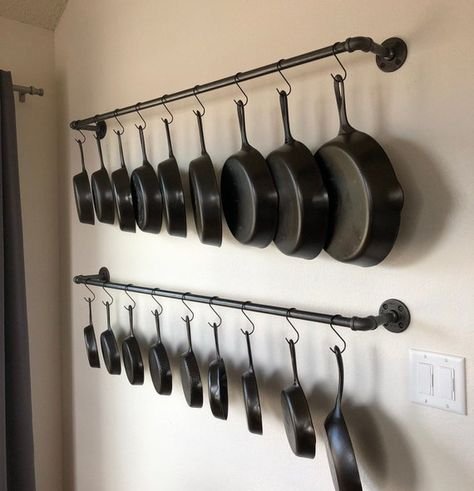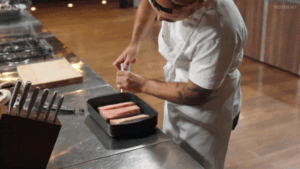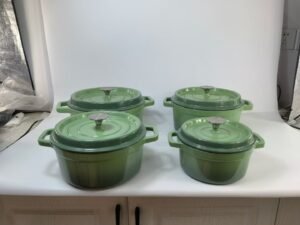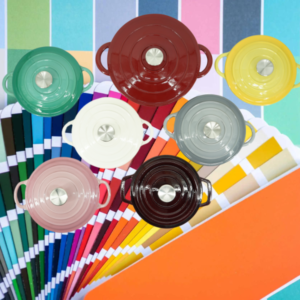When it comes to choosing cookware, it can be a little overwhelming trying to decide between cast iron and stainless steel.
Both have their benefits and drawbacks, so it’s important to know the differences so you can make an informed decision.
In this post, we’ll go over the pros and cons of each to help you decide which is best for your kitchen.
Cast iron cookware is great for heat retention and durability, which makes it perfect for slow cooking and high-heat searing.
Stainless steel cookware is lighter, easier to maintain, and perfect for cooking delicate foods.
Which one you choose depends on what you like to cook and how you like to cook it.
Now, let’s dive into each type of cookware so you can decide which is best for your kitchen.
The Main Differences in Cooking
Cast Iron:
- Heat Retention: Cast iron retains heat exceptionally well, which makes it ideal for tasks like searing meat or slow-cooking stews.
- Heat Distribution: It distributes heat evenly across the surface, reducing hot spots.
- Cooking Versatility: Can be used on the stovetop, in the oven, or over a campfire.
- Non-Stick Properties: When properly seasoned, cast iron develops a natural non-stick surface.
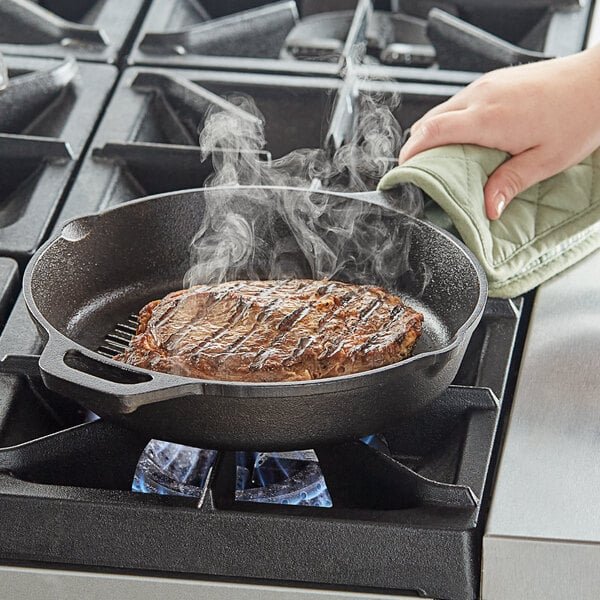
Stainless Steel:
- Heat Conduction: Heats up quickly and responds well to temperature changes, offering precise control.
- Browning: Excellent for browning and deglazing, which is perfect for making sauces.
- Versatility: Suitable for a variety of cooking methods but not typically used in the oven at very high temperatures.
- Acidic Foods: Non-reactive, making it ideal for cooking with acidic ingredients like tomatoes and wine.
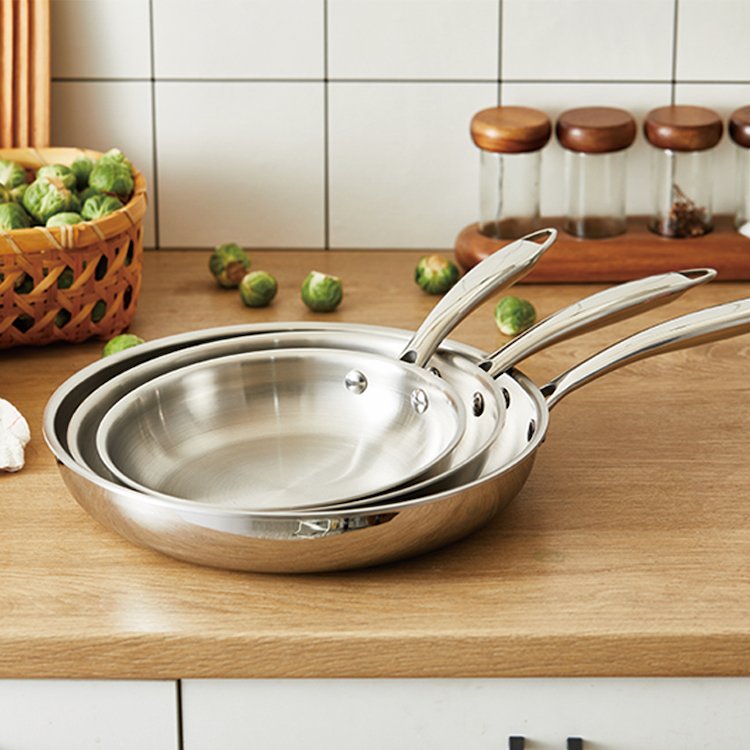
The Differences When Cleaning
Cast Iron:
- Cleaning Method: Requires careful cleaning without soap (usually rinsing with hot water and scrubbing with a brush). Soap can strip away the seasoning.
- Seasoning: Needs to be seasoned regularly to maintain its non-stick surface and prevent rusting.
- Storage: Must be completely dry before storage to prevent rust.
Stainless Steel:
- Cleaning Method: Can be cleaned with soap and water. Stubborn stains may require a stainless steel cleaner or a vinegar solution.
- Dishwasher: Generally dishwasher safe, although hand washing is recommended to maintain the finish.
- Maintenance: Minimal maintenance compared to cast iron; no seasoning required.
Which Pan to Choose?
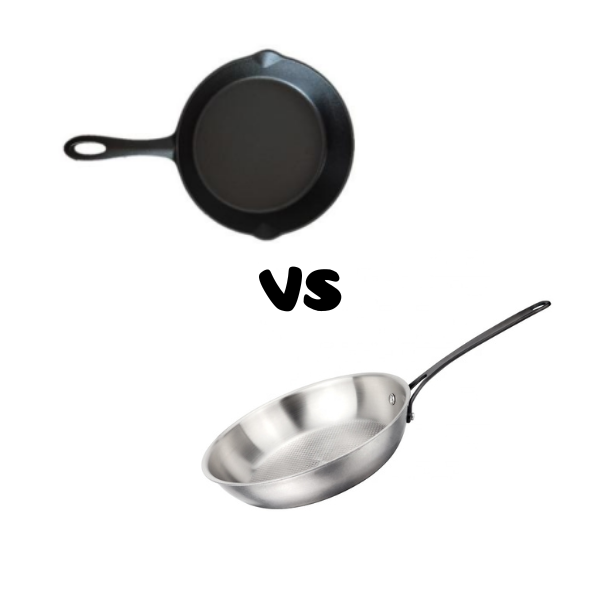
Choosing between cast iron and stainless steel comes down to your cooking style and how much maintenance you’re willing to do:
- Choose Cast Iron If:
You need excellent heat retention for tasks like searing steaks or slow-cooking stews.
You enjoy cooking with traditional, durable cookware.
You don’t mind the regular maintenance of seasoning and careful cleaning.
- Choose Stainless Steel If:
You want precise temperature control and quick heat response for tasks like sautéing and browning.
You prefer low-maintenance cookware that’s easy to clean.
You often cook with acidic foods and need a non-reactive cooking surface.
Is it Better to Cook with Stainless Steel or Cast Iron?
Stainless steel pans are durable, easy to care for, and perform well when cooking delicate items, but they do not retain heat as well as cast iron.
Cast iron pans are extremely durable and excel at retaining heat, but they require more maintenance and may be more difficult to work with when cooking delicate items.
Stainless steel is great for tasks like sautéing vegetables or cooking fish, where precise temperature control is essential.
What are the Disadvantages of Cast Iron Cookware?
The disadvantages of cast iron include the regular maintenance of seasoning and careful cleaning to prevent rust and maintain their non-stick surface.
Improper cleaning or using harsh cleaning agents can strip away the seasoning and damage the pan.
Additionally, cast iron is heavy and can be cumbersome to handle, especially when full of food.
Why Would Someone Choose a Stainless Steel Skillet Over Cast Iron?
Stainless steel cookware is easier to clean and maintain than cast iron, requiring minimal effort and being resistant to rust and staining.
It’s a great choice for busy kitchens where convenience and ease of use are priorities.
Stainless steel is also non-reactive, meaning it won’t interact with acidic foods, making it ideal for cooking dishes with tomatoes, wine, or citrus.
Which is Better: Cast Iron or Steel?
Cast iron pans hold heat better. Cast iron cookware takes longer to heat up but holds heat longer than carbon steel. This makes cast iron great for pan frying and roasting.
Cast iron skillets have a classic design and are known for developing a natural non-stick surface with proper seasoning.
However, carbon steel, a lighter alternative, also holds heat well and is often used by professional chefs because it’s versatile.
Cost Comparison of Cast Iron and Stainless Steel Cookware
Cast iron cookware is generally less expensive upfront than high-quality stainless steel. However, it requires more maintenance, which can add to the long-term cost.
Stainless steel is more expensive initially but requires less upkeep, making it more cost-effective over time.
For example, a good cast iron skillet might cost around $30-$50, while a high-quality stainless steel skillet could be $100-$200 or more.
Consider your budget and how much time you’re willing to invest in maintenance when making your decision.
Cast Iron vs Stainless Steel Health
Both cast iron and stainless steel are safe for cooking. Cast iron can leach small amounts of iron into food, which can be a good thing for some people, especially those with iron deficiencies.
Stainless steel is non-reactive, so it’s perfect for cooking acidic foods without changing the flavor.
However, you want to make sure you get good quality stainless steel cookware so you don’t get any leaching of nickel or chromium in trace amounts.
Popular Cast Iron Cookware Items
- Dutch Oven
- A cast iron Dutch oven is perfect for slow-cooking, stews, and baking because it holds heat and cooks evenly.
- Grill Pan
- A cast iron grill pan is perfect for grilling meats and vegetables because it has ridges that create grill marks and allow the excess fat to drain away.
- Skillet
- A cast iron skillet is versatile and durable. You can fry, sear, and bake with it. You can go from stovetop to oven with no problem.
- Griddle
- A cast iron griddle provides a large, flat cooking surface, perfect for pancakes, bacon, and other breakfast items.
- Braising Pan
- A cast iron braising pan is perfect for slow-cooking meats and vegetables because it has a heavy lid and deep sides.
- Pizza Pan
- A cast iron pizza pan ensures a crispy crust and even cooking, making it perfect for homemade pizza.
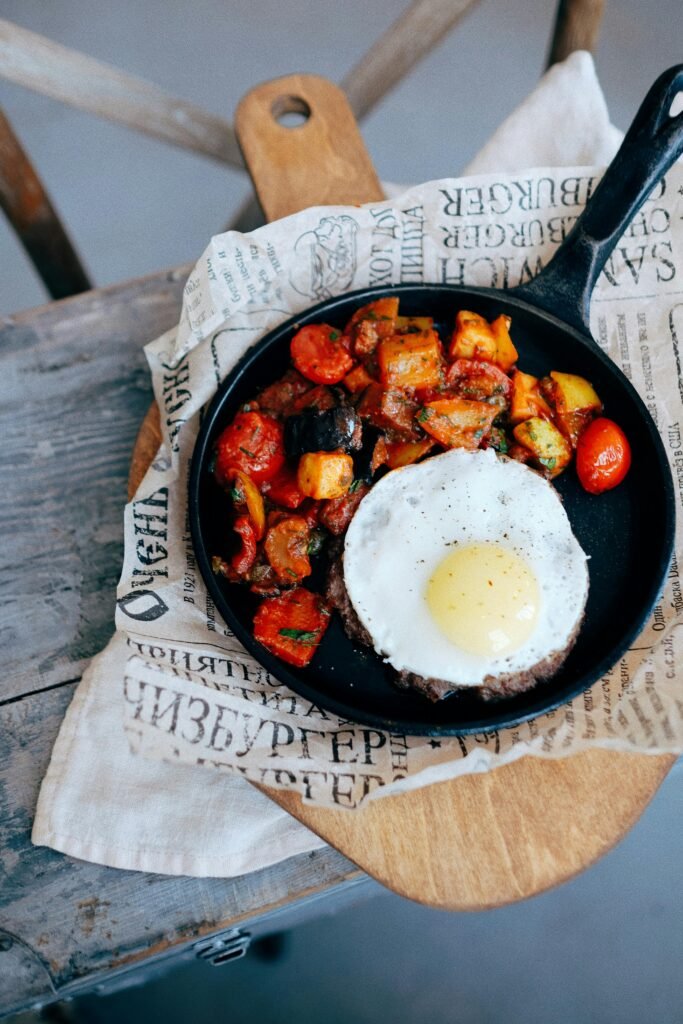
Sourcing cast iron cookware manufacturer and supplier?
Meiloz offering high level custom cookware solution to enhance your field.
Popular Stainless Steel Cookware Items
- Saucepan
- A stainless steel saucepan is perfect for making sauces, boiling, and reheating. It’s a versatile piece of cookware that you need in your kitchen.
- Stockpot
- A stainless steel stockpot is perfect for soups, stews, and cooking large batches of food. It’s durable and easy to clean.
- Sauté Pan
- A stainless steel sauté pan is perfect for browning, sautéing, and making one-pan meals. It has high sides and a large surface area.
- Frying Pan
- A stainless steel frying pan is perfect for frying eggs, sautéing vegetables, and quick cooking tasks. It’s lightweight and easy to handle.
- Roasting Pan
- A stainless steel roasting pan is perfect for roasting meats and vegetables, providing even heat distribution and easy cleanup.
- Double Boiler
- A stainless steel double boiler is perfect for melting chocolate, making custards, and other delicate tasks. It ensures gentle, even heating.
Cast Iron vs Stainless Steel Pan for Steak
For cooking steak, people prefer cast iron because it holds heat and gives a great sear. You can use stainless steel, but it may not sear as well as cast iron.
The even heating and ability to get hot make cast iron the preferred choice for many chefs when cooking steaks.
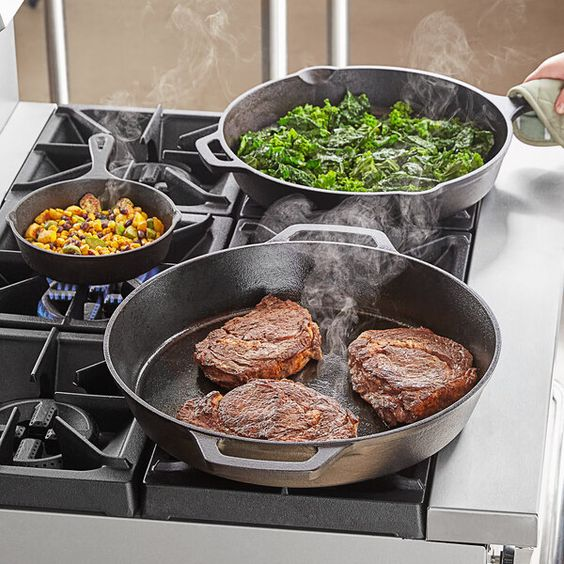
Cast Iron vs Steel:
Final Thoughts When you’re deciding between cast iron and stainless steel, think about how you cook and what you want to do with your cookware.
Cast iron is great for people who like to slow cook and sear with high heat.
Stainless steel is great for people who want convenience and versatility.
A combination of both types of cookware is probably the best solution for a well-equipped kitchen.
Summary:
Which one is better, cast iron or stainless steel cookware? It depends on what you need and how you want to maintain it. They both have their pros and cons.
If you want something that will last forever and hold heat, go with cast iron. If you want something that’s easy to maintain and versatile, go with stainless steel.
Go to Meiloz Cookware to learn more and get the best.

